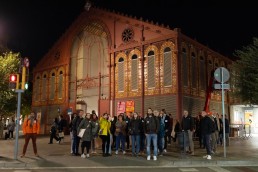
Urban Glow: Night Walks in Barcelona
(Spain) – SCEWC (Smart City Expo World Congress) and CICAT (regional Catalan lighting Cluster) hosted a Barcelona NightSeeing night walk, aiming to raise awareness of light and shadow in night time environments in cities for government and lighting decision-makers from Europe and America.
The night walk in Barcelona, Urban Glow, encouraged attendees to discover the nocturnal landscape of Barcelona’s Sant Antoni neighbourhood. The event’s walking route underscored the values of after-sunset experiences of visual quality by experiencing the streets, street corners, an evening market, neon signs, and eccentric streetlights.
The objective was for leaders in the lighting industry and governmental civil servants to return to their cities, companies, or organisations to influence and advocate for liveable and safe night time environments for businesses, late shift workers, night clubbers and those traversing the nocturnal streets and pavements.
The tour was conducted by New York-based urban lighting designer Leni Schwendinger, supported by the local context knowledge of Alberto Barberá, lighting designer of Anoche Iluminació. Schwendinger, known for her work in urban lighting, public art, and urban infrastructure, created NightSeeing, in which, through city tours, she shares her deep knowledge of light and dark in everyday life.
During the programme attendees learned how implementing a thoughtful urban lighting design helps prevent traffic accidents by improving visibility, while also increasing citizens’ sense of safety. Creative and functional illumination in public space, such as the pavement and plazas, encourages after-dark space usage and facilitates orientation through illuminated accents, such as façades, monuments, and brightened street crossings. A well-lit environment can encourage economic activity through late open-hours and for the adoption of sustainability to ensure longevity.
During the walk attendees evaluated the lighting successes, missteps, and oversights in the city’s nightscape. The journey was analysed and studied beforehand to elicit participant opinions on aspects of urban lighting – controversial, neglectful, or well designed. The route covered several streets of Eixample and culminated in the renovated Sant Antoni’s Mercat, which features a tactical urbanism approach.
As a result, quality urban lighting design emerged as essential to ensure the safety and welfare of the population. This also pinpointed was the need to consider the natural darkness dusk through dawn including the circadian cycles of biodiversity.
The CICAT Lighting Cluster promotes this type of initiatives with the aim of promoting an innovative, efficient, and healthy Light Culture. To learn more about their objectives through their website: www.clusteriluminacion.org



